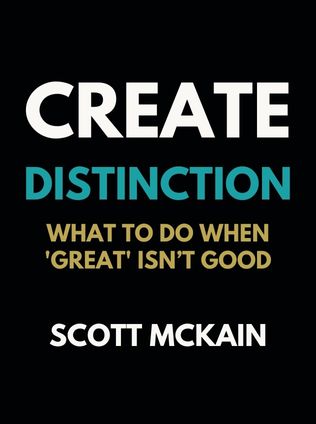
Create Distinction
What to Do When 'Great' Isn’t Good
By Scott McKain
Published 03/2013
About the Author
Scott McKain is a recognized expert in the field of business and professional distinction. He is the chairman of McKain Performance Group and cofounder and principal of The Value Added Institute, a think tank focused on the role of the customer experience in creating significant advances in client loyalty. With his expertise, McKain has authored several books, including the well-regarded Create Distinction, which provides a roadmap for businesses and professionals looking to stand out in a crowded marketplace.
Main Idea
In Create Distinction, Scott McKain addresses the critical need for businesses and professionals to differentiate themselves in an increasingly homogenized world. He argues that merely being "great" is not enough to grow a business; instead, one must achieve true distinction. Through practical advice and insightful analysis, McKain identifies the major obstacles to differentiation and offers a framework for creating unmistakable value and standing out from the competition.
Table of Contents
- Introduction
- How We Got Into This Mess: The Three Destroyers of Differentiation
- The First Cornerstone: Clarity
- The Second Cornerstone: Creativity
- The Third Cornerstone: Communication
- The Fourth Cornerstone: Customer-Experience Focus
- Conclusion
Introduction
Scott McKain begins by highlighting the widespread homogenization across various industries, leading to a lack of distinction among companies. He notes that customers are becoming increasingly disillusioned with businesses that offer little differentiation. McKain emphasizes the importance of standing out to achieve sustained growth and profitability. He sets the stage for the book by outlining his approach to creating distinction, which involves understanding and addressing the key destroyers of differentiation.
How We Got Into This Mess: The Three Destroyers of Differentiation
Differentiation Destroyer #1: Copycat Competition and Incremental Advancement
McKain explains that when faced with competition, businesses often respond by either imitating their competitors' advancements or making incremental improvements. Both approaches fail to create true distinction and instead lead to a homogenized market. He provides examples from the mobile phone industry, where many manufacturers attempt to create the next "iPhone killer" without offering significant innovations.
“Notice the problem: in both examples, all efforts are based upon what my competitor is doing, not necessarily what my customers desire.” - Scott McKain
Differentiation Destroyer #2: Change That Creates Tougher Competition
The rise of the internet has made information and competition more accessible to customers. This shift has intensified the challenge for businesses to differentiate themselves. McKain illustrates this point with the example of the car buying process, where customers often possess as much information as the salespeople, reducing the perceived value of the sales experience.
“Today, when a customer walks onto a car lot to purchase a new or used vehicle, they frequently possess practically the same information as the salesperson with whom they will be negotiating.” - Scott McKain
Differentiation Destroyer #3: Familiarity Breeds Complacency
McKain argues that when products and services become too familiar, customers begin to take them for granted. This complacency leads to a lack of customer retention strategies and ultimately undermines the business. He emphasizes the need for companies to continually innovate and engage their customers to maintain their interest and loyalty.
“If customers know your routine almost as well as you do, you have substantial problems.” - Scott McKain
The First Cornerstone: Clarity
Clarity is essential for creating distinction. McKain stresses the importance of having a clear understanding of who you are as a business or professional. This clarity helps define what makes you compelling and unique. He introduces the concept of a "high concept" statement, a short, powerful phrase that encapsulates what makes your business different.
- Developing Your High Concept: Consider what makes your business different, better, and unique from your competition.
- Defining Values: Identify the core values of your organization and how they can form the basis of your high concept statement.
“One of the best exercises I've developed for clarity stems from an approach I related in my first business book, Expand Distinction: ALL Business Is Show Business.” - Scott McKain
The Second Cornerstone: Creativity
Once clarity is established, creativity becomes the next cornerstone of distinction. McKain explains that creativity must be directed and purposeful, aligning with the established clarity. He outlines steps to inspire productive creativity:
Sign up for FREE and get access to 1,400+ books summaries.
You May Also Like
The Subtle Art of Not Giving a F*ck
A Counterintuitive Approach to Living a Good Life
By Mark MansonRich Dad Poor Dad
What the Rich Teach Their Kids About Money - That the Poor and Middle Class Do Not!
By Robert T. KiyosakiHow To Win Friends and Influence People
The All-Time Classic Manual Of People Skills
By Dale CarnegieQuiet: The Power of Introverts
The Power of Introverts in a World That Can't Stop Talking
By Susan Cain



















